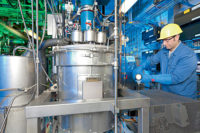Focusing on Research and Development in the Adhesives and Sealants Industry
Though the events of the past two years have posed significant potential roadblocks to research and development efforts, companies in the adhesives and sealants industry are still focused on innovation.

How digitized is your R&D process now compared to 5-10 years ago? What changes do you foresee for the next 5-10 years?
Thomas Lys, Director of Technical Services Construction, Omya, Inc.: We are following the trends on digitalization, such as 3D printing or high-throughput experiment (HTE) systems. Partnering with universities using digitized systems convinced us that this is the right approach. We expect in the next 5-10 years to have more automated processes, which will free up resources for other projects.
Vinita Sharma, Vice President, Product Management & Development, Berry Global: Especially during the last two years of the COVID-19 pandemic, we relied even more heavily on digital platforms to connect us with colleagues and customers around the world. As a global company, we leverage our digital platforms to engage cross-functional teams to support the R&D process.
Centralization of data and processes will be the main focus over the next 5-10 years. As the work environment continues to decentralize, it will be more crucial for information to be digitized and shared across the organization. Interconnecting the development process will require us to have centralized information and processes.
Michael Todd, Global Head of Innovation, Henkel Adhesive Technologies: The way we think about innovation and the way we run our innovation processes and activities have completely changed in the last five years. The speed and impact of the digitalization is a real game-changer for us that allows us to develop products faster and meet the needs of our customers more accurately. All our data, including experimental information, formulation information, and market intelligence information, today is collected in a structured data platform and shared dynamically in real time everywhere across in the world.
We are now able to run fully digital laboratories leveraging Industry 4.0 automation and machine learning tools that help increasing speed and efficiency dramatically. Today we are collecting data from more than 10 million R&D tests every year from around the world—something that was not possible five years ago. All this data, as well as new machine learning algorithms, help us to predict material properties and performances of new solutions before our customers have asked for them. This digital-enabled change has created a new era in the way we think about innovation as well, and this has been fully reflected in the conception of our new Inspiration Center Düsseldorf and in the construction of another global innovation center in Shanghai, which will start operating in 2023.
Today, our infrastructure and global teams are organized to maximize the value of this development. In the next five to 10 years, we can expect a further advancement of data models and analytics, which will create an even higher level of artificial intelligence to utilize these data across predictions, processes, and formulations for intelligent and sustainable designs.
What end-use sectors are most prompting your development efforts?
Looking for a reprint of this article?
From high-res PDFs to custom plaques, order your copy today!






